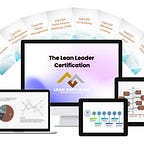A3 Thinking in Action: A Step-by-Step Guide to Effective Problem Solving
In the dynamic landscape of business and continuous improvement, A3 thinking has emerged as a powerful tool, providing a structured and systematic approach to problem-solving. Originating from Lean manufacturing principles, the A3 methodology has transcended its manufacturing roots to become a widely adopted framework in various industries. For the best A3 Thinking templates, visit lean simplified.
Step 1: Define the Problem Clearly
The first step in A3 problem-solving is to clearly define the problem at hand. This involves understanding the current situation, identifying the gap between the current state and the desired state, and framing the problem in a concise and specific manner. Clarity in problem definition sets the foundation for effective problem-solving efforts.
Step 2: Grasp the Current Situation
Once the problem is defined, the next step is to thoroughly grasp the current situation. This involves collecting relevant data, conducting root cause analysis, and creating a visual representation of the current state. Visual tools such as process maps, fishbone diagrams, or Pareto charts can be employed to enhance understanding and communication.
Step 3: Set a Target and Goal
With a clear understanding of the current situation, it’s time to set a target and goal for improvement. Define what success looks like and establish measurable objectives that will guide the problem-solving process. This step provides a clear direction and purpose for the team, aligning efforts with organizational objectives.
Step 4: Analyze Root Causes
Digging deeper into the problem, the fourth step involves identifying and analyzing the root causes. A variety of problem-solving tools such as the “5 Whys” or cause-and-effect diagrams can be used to systematically explore the underlying issues contributing to the problem. This critical analysis helps in addressing the core issues rather than just treating symptoms.
Step 5: Develop Countermeasures
Armed with a comprehensive understanding of the problem and its root causes, it’s time to develop countermeasures. These are specific actions and strategies designed to eliminate or mitigate the identified root causes. The focus is on creating effective solutions that align with the set target and goals.
Step 6: Implement Countermeasures
Implementation is a pivotal phase in A3 thinking. It involves executing the identified countermeasures and monitoring their impact on the problem. Effective communication and collaboration within the team are crucial during this phase to ensure a smooth and coordinated implementation process.
Step 7: Evaluate Results
After implementation, evaluate the results against the established goals and targets. This step involves measuring the effectiveness of the countermeasures and assessing whether the problem has been successfully addressed. Data-driven evaluation provides valuable insights for ongoing improvement efforts.
Step 8: Standardize Successful Processes
To sustain improvements, the final step is to standardize successful processes. Document the new standard procedures, update training materials, and ensure that the changes become an integral part of the organization’s practices. Standardization fosters consistency and prevents the recurrence of similar problems.
Benefits of A3 Problem-Solving
The A3 problem-solving process offers several benefits to organizations:
- Structured Approach: A3 thinking provides a structured and systematic approach to problem-solving, guiding teams through a logical sequence of steps.
- Visual Communication: The use of visual tools in A3 reports enhances communication and understanding, making complex issues more accessible to team members and stakeholders.
- Data-Driven Decision-Making: A3 thinking encourages data collection and analysis, promoting informed and data-driven decision-making.
- Continuous Improvement: By addressing root causes and implementing effective countermeasures, A3 problem-solving contributes to a culture of continuous improvement within organizations.
Conclusion: Empowering Organizations Through A3 Thinking
A3 thinking, when effectively applied, empowers organizations to tackle challenges with clarity, precision, and strategic intent. By following the step-by-step guide outlined above, organizations can harness the full potential of A3 problem-solving, fostering a culture of continuous improvement and resilience in the face of complex problems. As organizations navigate the ever-evolving landscape of business, A3 thinking stands as a reliable compass, guiding them toward effective solutions and sustainable success. Lean simplified also offers the best lean training online, visit their website to learn more.
Key Takeaways
- Clarity in Problem Definition: A3 thinking begins with a clear and concise definition of the problem, setting the stage for effective problem-solving efforts.
- Thorough Understanding of the Current Situation: Grasping the current situation involves data collection, root cause analysis, and visual representation to enhance understanding and communication within the team.
- Setting Clear Targets and Goals: Establishing measurable objectives provides a clear direction for the problem-solving process, aligning efforts with organizational objectives.
- Root Cause Analysis: A3 thinking emphasizes the importance of identifying and analyzing root causes, going beyond surface-level issues to address the core factors contributing to the problem.
- Development and Implementation of Countermeasures: Effective solutions are developed based on the identified root causes, and a coordinated implementation plan is executed to address the problem.
- Results Evaluation: After implementation, the results are rigorously evaluated against set goals and targets, providing valuable insights for ongoing improvement efforts.
